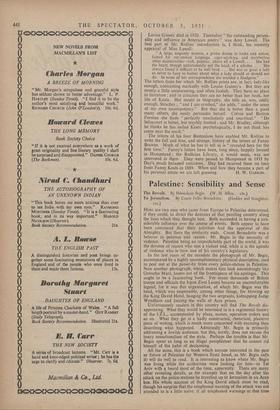Light on Fanny Brawne
IN this typically Boston book there is a good deal more about the Bostonians than about Keats. There are four of them: two women —Louise Imogen Guiney and Amy Lowell—and two men—Fred Holland Day and Louis Arthur Holman. In all America,- we are told, no four people have done so much for Keats. In this book they do not do much for Keats, but a good deal for Fanny Brawne. They are concerned, in truth, to rbake a better woman of her ; using for the purpose her letters to Fanny Keats. "Behind their partially successful efforts," says Mr. Rollins, " there lies a tale, part of which must have- pleased the Comic Muse." Mr. Rollins unfolds the tale in an introductory essay wholly admirable. The bulk of the book consists of 105 letters written by the four Bostonians (Amy Lowell 46, Day 42, Louise Guiney a modest 10, Holman a business-like, but rather perfunctory, 7). The 'reader is advised (very sensibly) to read the introduction first, and the letters afterwards. He will certainly enjoy the introduction. I should be surprised if the letters did not a little disappoint him.
Over the Boston tea-parties of the " Gay Nineties" Louise Imogen Guiney sat queen—" the most vital and creative personal influence in the lives of all of us" says one of her salon, Ralph Adams Cram (so great a man that he must have known what he was talking about). A favourite rendezvous was "Day's fantastic house in Nonvood." Day was one of Louise Guiney's "nice boys," one of the " brainy " ones. She writes to him as "Dear Nanki-Pooh," "Dear Sonny," "Me Boy " ' • signing herself, once at least, "Your Willy and stupid Quinck." Most of her letters are, in fact, a little vulgar. Day is preposterous. But Mr. Rollins forres a good deal to him, because Louise Guiney forgives everything. "Rather a crank, but made up of goodness" she calls him ; and, yet again, "a human being of the right breed."
Louise Guiney died in 1920. Thereafter "the outstanding person- ality and influence in American poetry" was Amy Lowell. The best part of Mr. Rollins' introduction is, I think, his masterly appraisal of Miss Lowell: "A large, ungainly woman, a prima donna in looks and action, famed for out-spoken' language, cigar-smoking, and numberless other eccentricities—rich, popular, above all a Lowell.... She had the heart, though unfortunately not the head, of a scholar.... She always found it difficult lb.be well bred.... She was so great a lady as never to have to bother about what a lady should or should not
do. In some of her correspondence she wielded a bludgeon." ' The letters from her which Mr. Rollins prints are, in fact, lady-like enough, contrasting markedly with Louise Guiney's. But they are mostly a little uninteresting, and often foolish. They, have no place in literature ; and in criticism they are no better than her book, her life of Keats. Her model in biography, she tells us, was, oddly enough, Strachey ; "and I am crushed," she adds, "under the sense of my own incompetency." But that she is better than a good many others, she easily persuades herself. Colvin and Buxton Forman she finds perfectly unscholarly and uncritical." "De Selincourt is better, but terribly limited ; and Mr. Bradley, although he thinks he has nailed Keats psychologically, I do not think has come near the mark."
The letters of his four Bostonians have enabled Mr. Rollins to write the full and true, and strange, history of the letters of Fanny Brawne. Much of what he has to tell us is "revealed here for the first time." Fanny's letters have been, long since, happily housed in Hampstead ; the Bodleian Library, it would seem, was not interested in them. They were passed to Hampstead in 1933 by Day's much harassed executors. Day had received them on loan from Fanny Keats in 1889. When and how they became a part of
his personal estate we are left guessing, H. W. GARROD,






















































 Previous page
Previous page